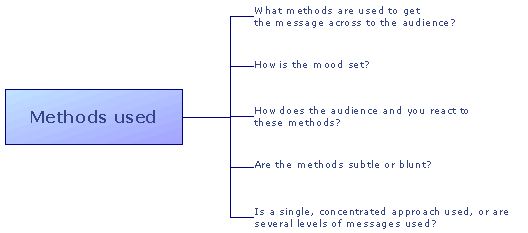Setting of the audience
The third setting you should think about is where and when the book or movie is being read or seen. Unless it’s a new one, there are usually two settings to consider - where and when you’re reading or viewing it, and the original setting when it was first published or released.
Take the original King Kong movie, for instance. Seeing it today, it looks like a movie with a horribly bad plot and very mediocre special effects. But that is what it looks like to today’s audience. It was released more than 70, yes 70, years ago. Back in 1933, just the idea of a gigantic, prehistoric gorilla was shocking. But bringing a 30-foot-tall ape to life on film amazed audiences, when film was still in its infancy and special effects seemed more like magic than craft.
The place where the movie is expected to be seen is also important. For instance, the 1940 movie The Great Dictator by Charlie Chaplin is a parody of Nazism and the major historical figures such as Hitler and Mussolini. Released in 1940 during World War II, the movie was banned in German-occupied Europe, South America, and Ireland, but was a raging success in many countries on the allied side. For movies like this, knowing the location of the intended audience is an important part of your review.

When you step into the movie theatre, check out the other people walking in with you. What sort of demographic is represented? Are the sexes split evenly, or are there more males or females. For instance, corny action movies generally tend to attract a mostly male crowd. What about the age of the crowd? Is it a kid’s movie? Or is it a violent thriller attracting an entirely adult crowd? Are the oldies out in force tonight, or is it all young adults in their twenties? Is it a particularly upper- or lower-class crowd?
Whether it’s a book, movie, or play, think about what crowd is actually being reached, and then whether this is the intended audience. Sometimes a movie’s title may be deceptive, and people who haven’t done any reading might come and see it on face value. Occasionally, either due to the title or an incorrect rumour, the wrong sort of crowd will turn up to a movie in large numbers and thoroughly not enjoy it.
Check out other people’s reactions to the movie or play as you watch it. See whether there are lots of laughs if it’s a comedy, or lots of screams if it’s a horror film. If it’s a book you’re reviewing, hopefully there are other students reading it at the same time. Talk to them and find out their reactions. If it’s not a recent release, read some reviews, and have the reviewer’s comments in your head as you watch or read. Perhaps you’ll agree with them, perhaps you’ll think they don’t have a clue. Some people, however, prefer to hit a movie/play/book fresh and to draw their own conclusions, without reviewer’s words echoing in their head. Do what works best for you.
Think about how certain points in a book or movie may have been crafted to suit the audience. For instance, a war movie like Saving Private Ryan starts and ends with a scene in a graveyard for American soldiers, with an American flag waving patriotically in the background. Because it’s a very ‘Hollywood’ movie, made in the United States, it has been made with a very American ‘feel’. Other considerations that may change the book or movie to suit the audience are ratings and age limits. A movie like Alien versus Predator, for instance, was purposefully ‘softened’ so that it could have a PG rating, rather than an M or MA rating (which would have reduced the potential number of viewers). However, in doing so, the director put off a lot of the ‘hardcore’ fans who liked the original, highly violent and scary Alien films. This sort of thing is great stuff to discuss in your review.


As well as enjoying the book or movie, think about the ‘methods’ the writer, director, and actor use to achieve their purpose, whether that be to communicate a moral message, to make the audience laugh, or to make you sit back and think about how wonderful life is. For instance, a film like Schindler’s List is shot almost entirely in black and white. A comic-book or graphic-novel based film like Sin City, on the other hand, is mostly black and white, but people’s eyes, blood, and some clothes appear brightly coloured. These are just some of the methods that can be used for great effect.
Audience reaction to these methods is important too. In a horror film, sudden ‘clashes’ (like you’d get from hitting a cymbal) of music are sometimes used when a killer suddenly comes onto screen to heighten the effect. Watch the audience and see how they react. This particular technique is regarded by many filmmakers as shoddy film making - they believe that a true scare requires no help from a loud musical clash. Sometimes a director or writer launches a multi-pronged ‘attack’ on the viewer or reader. Try to be aware of all the methods they use, not just the more obvious ones.

The genre of a movie or book generally means what type of work it is. For instance, some movie types are horror, thriller, comedy, tragedy, war, and documentary. Books can be dramas, epics, comedies, satires and so on. Sometimes a book or movie will span multiple genres. For instance, the Star Wars films, while initially appearing to be in the science fiction genre, are actually better described as being Westerns, just set in space.
The tone of a story is often set in the first few minutes or lines. The first 30 minutes of the film Saving Private Ryan very quickly sets the tone of the whole film - the terrible carnage and loss of life in the opening scene tells the viewer that this is not going to be a light hearted or glorifying account of war, but rather a film condemning war. Often a book will begin with an exciting introduction that sets the tone, before settling into the narrative.
Click here to move on to the next topic: Difference between mood and tone